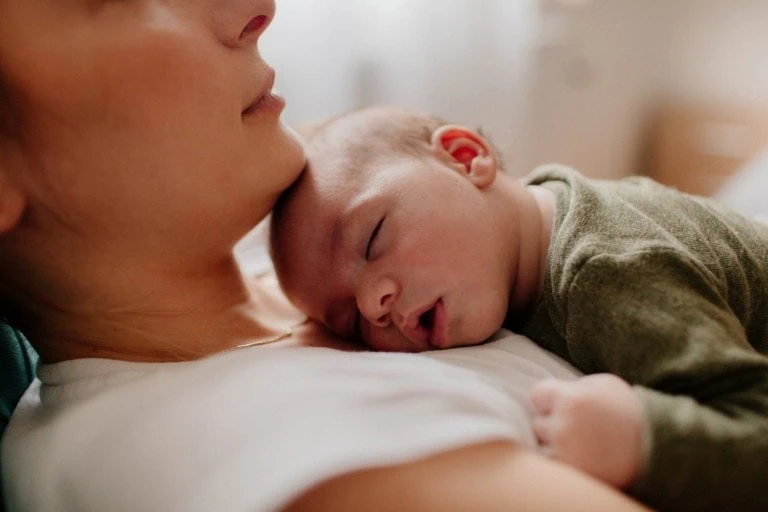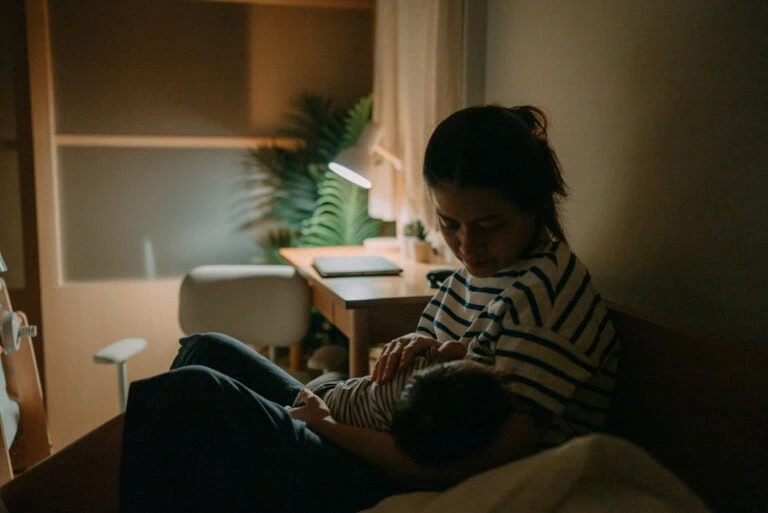I often teach about the impact of environment and temperature on a child’s sleep. Some questions families often ask are, “What should my child wear at night?” “Should they be warm?” “Should they be cold?” “Do I swaddle?” When I was a first-time mom, all I knew leaving the hospital was the need to “keep her warm” and “keep her swaddled.” I received so much information about feeding and postpartum recovery but how to dress my baby appropriately for safe sleep was not on the list.
Little did I expect after coming home through the newborn blur and a convenient little trip to the baby store that there was a whole world of sleep sacks, transitional swaddles, TOG ratings, and a wide variety of sleepers. Six years later, with a mountain of sleep education behind me, I knew this was one under-discussed topic with very little guidance given to new parents.
Best Environment and Temperature for Safe Sleep
Let’s start with the room environment and temperature. The best temperature for sleep in a nursery found in most studies is 68-72ºF for both optimal and safe sleep.1 It may seem a little chilly, but our body temperature naturally drops at night. Keeping your environment at a cooler temperature allows your body to stay in that natural sleep.
Studies have shown that sleeping in a room above 70°F triggers slow production of melatonin, our natural sleep hormone.2 Keeping the temperature cooler allows for more time for deep sleep. While parents often worry about their babies being too cold at night, studies found that going to bed too warm had impacts on sleep safety.3 These studies also indicate that having a child that is too warm or going to bed overheated is linked to an increased risk of sudden infant death syndrome (SIDS).
Dress Them Based on How It Feels
But what about when 70° feels different during different seasons? The American Academy of Pediatrics (AAP) doesn’t suggest specific temperature ranges to account for these variances. Instead, they recommend dressing your baby appropriately based on the feel. For example, if it “feels” much like 70°, you will want to consider a long-sleeved sleeper and a sleep sack.
What About Those TOG Ratings?
Your sleep sack will have a TOG rating or a Thermal Overall Grade, a unit of measure from .5-3.5 of insulation. The TOG rating correlates to the temperature best for that sleep sack. For example:
- 0.5 TOG rating is optimal for 74-78°F and typically made with material such as cotton muslin
- 1.0 TOG rating is perfect for 70-72°F
- 1.5 TOG rating is appropriate for 68-69°F
- 2.5 TOG is most appropriate for winter weather of 64-68°F — you will find these made of fleece or even a down material
Check Your Child’s Hands or Feet
Now, what do you do under that sleep sack? The best rule of thumb for dressing your baby at night with a sleep sack is to add a layer to what you’re wearing. For example, if you have light layers, you may want to opt for light organic sleeveless onesies.
In these room temperatures, however, it’s always best to check your child’s temperature for comfort by checking the back of their neck or chest to determine if they need more layers. Using their hands or feet, which are naturally cold or clammy, can be a mismeasurement of your child’s comfort because if they are cool to the touch, they are great!
Transitioning Out of the Swaddle
When determining your sleep sack or swaddle, remember to transition out of that swaddle by eight weeks. This transition time is because most babies will start developing signs of rolling and moving. You will notice that most swaddles will not have a TOG rating. These traditional swaddles include things like muslin blankets. In these cases, you will want to use your child’s core to determine comfort at night and to dress your baby for safe sleep.
If your child seems too warm, or you find yourself in the hot summer months with limited control over air conditioning, consider adding a fan. You can also put your child in a onesie instead of a long-sleeved sleeper. If your child is older than eight weeks, it will be time to look at a transitional swaddle or a sleep sack which will likely have various TOG ratings you can choose to match your environment.
A transitional swaddle can be great for the change from a full swaddle to a sleep sack. If you live in a warm area, consider a shirt only or a short-sleeved onesie. If you are in a much colder area, consider doubling up on the onesie. Remember, however, cool is best for your little one!













































